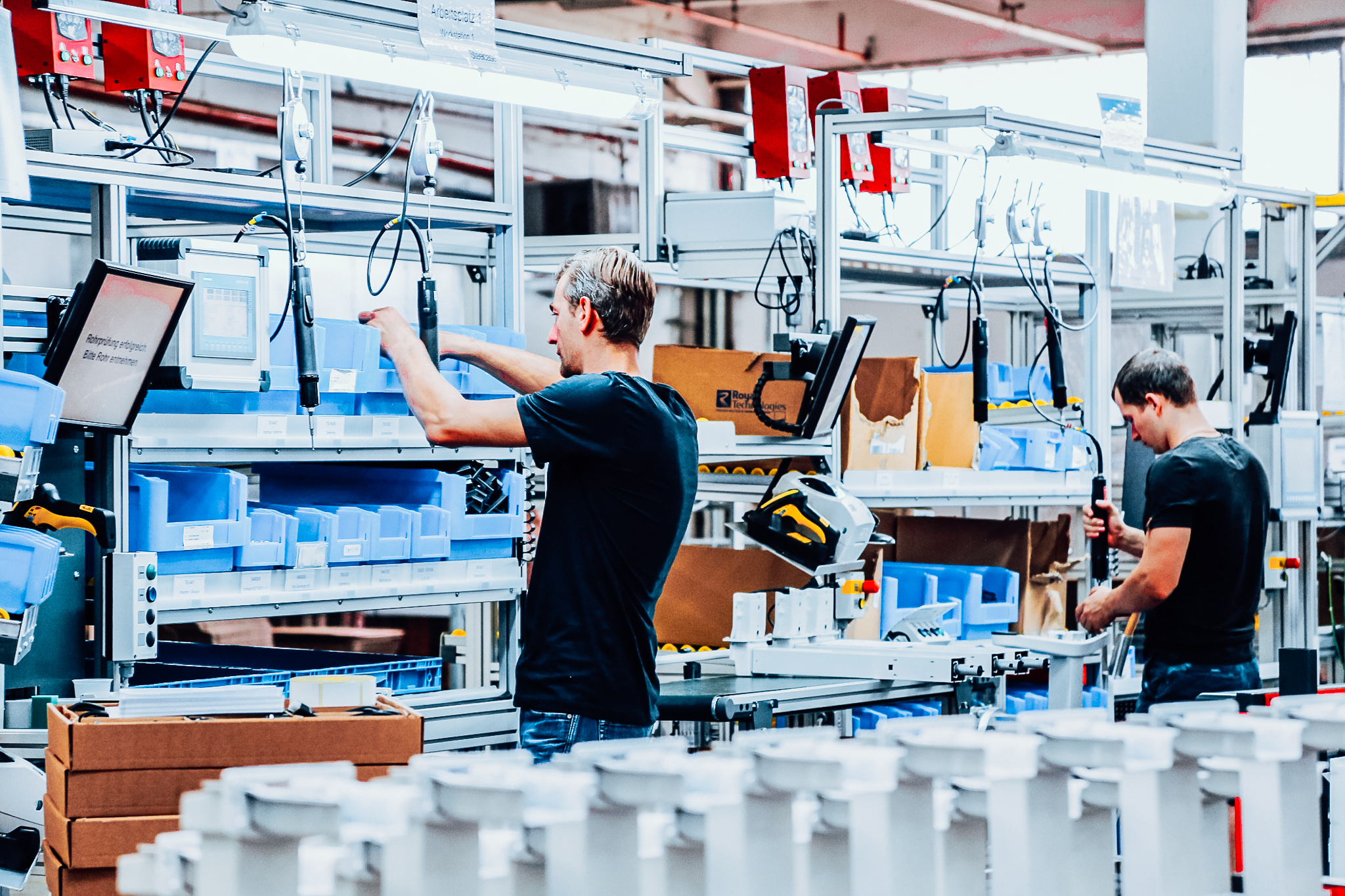In 2020, manufacturers have many good reasons to set ambitious goals and be optimistic about their business growth prospects. At the same time, they must wisely prioritize their investments and streamline their operations to successfully deal with the complexity, ambiguity, and uncertainty of today’s markets. Those who manage to take advantage of new opportunities and overcome the typical problems that plague most manufacturing facilities will emerge as market leaders and end the year successfully.
The State of Manufacturing in 2020
Despite modest global trade projections , manufacturers in Europe feel optimistic about the potential for both future sales and employment growth. The European manufacturing sector is supported by a low unemployment rate, which was down to 7.5 percent in June, almost one percentage point less than a year before.
Even US manufacturing, which is sometimes believed to be disappearing, has risen steadily since Q2 2009 (when it contributed €1.49 trillion to the economy), and it now contributes over €2.1 trillion to the country’s economy every quarter, according to the Bureau of Economic Analysis of the United States Department of Commerce.
The Future of Manufacturing: 2020 and Beyond study, led by IW Custom Research, revealed that nine out of ten manufacturers expect revenues to increase. Within that cohort, well over half (58 percent) anticipate a strong growth of 5 percent or higher per year over the next five years. What’s more, more than two thirds (70 percent) of manufacturers expect to increase the number of people that they employ over the next five years.
New Opportunities, New Challenges
The optimistic growth projections are supported by the plethora of new opportunities created by the fourth industrial revolution, commonly referred to as Industry 4.0, which is revolutionizing manufacturing by providing manufacturers with the opportunity to take advantage of advanced manufacturing capabilities and information technology (IT) throughout the entire product lifecycle.
The following five innovations are expected to lead the manufacturing industry in 2020 and beyond:
1. Internet of Things (IoT)
A lot has been said and written about the Internet of Things in the last few years alone, and there’s a good reason for it: the IoT market is expected to reach €238 billion by 2020 , and approximately 63 percent of manufacturers believe that applying IoT to products will increase profitability over the next five years.
IoT is the interconnection of computing devices embedded in everyday objects via the internet, enabling them to send and receive data over a network without requiring human-to-human or human-to-computer interaction. It has been helping manufacturers make informed strategic decisions and evolve in the increasingly digital-first business landscape by collecting critical production data from IoT-enabled machines and sensors and turning this data into actionable insights.
According to the Future of IoT report published by Ernst & Young LLP, the manufacturing industry is expected to spend the most on IoT solutions, followed by consumer IoT, transportation, and utilities. “IoT spending among manufacturers will be largely focused on solutions that support manufacturing operations and production asset management,” the report states. McKinsey estimates that IoT solutions in manufacturing will generate €1.1 to €3.3 trillion of economic value annually by 2025.
2. Predictive Maintenance
Predictive maintenance recognizes the need to act before an equipment failure occurs to minimize their negative impact on production. It relies on information provided by connected sensors to constantly analyze the condition of equipment during normal operation and schedule maintenance tasks as needed.
According to various sources , putting a functional predictive maintenance program in place can result in a tenfold increase in return on investment, 25–30 percent reduction in maintenance costs, 70–75 percent decrease of breakdowns, and 35–45 percent reduction in downtime.
Manufacturers today can easily reap the benefits of predictive maintenance, such as improvements in reliability, performance, and stability of the production process, with solutions like Legato Sapient TPM , which brings transparency into maintenance and makes efficient use of resources in the creation and planning of maintenance orders.
3. Artificial Intelligence (AI)
Artificial intelligence is revolutionizing manufacturing by helping companies anticipate market changes and optimize their supply chains, among other things. It encompasses several state-of-the-art technologies, such as machine learning, machine vision, and natural language processing, which work together to enable greater human-robot collaboration in discrete and process manufacturing alike.
The market size for AI in manufacturing has already surpassed €1 billion, and it is anticipated to grow at a CAGR of more than 40 percent from 2019 to 2025. Its growth goes hand-in-hand with the growth of the Internet of Things, which enables machines to connect to the internet and generate data that can be used by AI to learn new things about the production environment.
In addition to changing how products are manufactured, AI is also changing how they are designed with generative design. This iterative design process involves a program capable of generating a certain number of outputs that meet certain constraints, and its advantages include increased productivity, decreased manufacturing costs, and reduced material waste.
4. 5G Connectivity
Leading carriers are already rolling out 5G networks in countries around the world, and manufacturers have many reasons to look forward to the latest generation of cellular network technology. 5G offers much higher data rates and lower latency than 4G, and it has the capacity to seamlessly connect billions of devices to the internet, allowing for ever-larger volumes of data processing from anywhere.
Essentially, 5G makes it possible for manufacturers to easily create an ecosystem of smart devices, each monitoring different aspects of the working environment. 5G’s low latency and high-bandwidth capabilities can gather massive quantities of real-time information about equipment and feed it to machine learning algorithms for analysis.
5G’s excellent reliability and availability are expected to bring manufacturers closer to the edge of the network, which is where the data is being generated. Edge computing has many advantages over centralized data-processing, such as lower costs and reduced bandwidth.
5. Customer-Centric Manufacturing
While most manufacturers are still delivering engineering-led products and practice a ship and forget approach to interactions with customers, increasingly more manufacturers are rethinking their manufacturing process and making it more customer-centric.
Customer-centric manufacturing captures, analyzes, and uses customer data across the lifecycle of their relationship with their product to develop data-driven customer segmentations and predictive models that allow them to see how customers use the product and how they engage with the manufacturer.
This manufacturing approach is expected to gain significant traction in 2020 as more manufacturers realize that they must put customers at the core of their business to remain competitive and relevant in the era of specialty products and high customer expectations.
Manufacturing Roadblocks
To fully take advantage of the plethora of new manufacturing opportunities created by modern technology and ultimately meet all 2020 production goals, manufacturers have many roadblocks to overcome:
1. Improving internal production processes: All manufacturers want to increase their ROI, and one way how to achieve this goal is through the improvement of internal production processes. This inevitably involves the implementation of a computerized manufacturing system capable of tracking and documenting the transformation of raw materials to finished goods.
2. Strengthening customer relationships: The role of customers in the manufacturing process shouldn’t be overlooked, and all manufacturers should strive to strengthen their relationships with customers by storing more information about them. The stored information can be analyzed and used to better allocate resources and generate meaningful business intelligence.
3. Meeting growing customer expectations: Customers in 2020 have plenty of options to choose from, and meeting their growing expectations is one of the biggest roadblocks manufacturers must overcome to remain competitive and achieve their business objectives. Automation can help overcome this roadblock by minimizing human error and making production lines more efficient.
4. Increasing labor productivity: From the largest product-making business to the humble workshop, virtually all manufacturers in 2020 deal with the lack of skilled workers. Manufacturers need a manufacturing system that can help them understand current conditions and how they can be optimized to increase labor productivity without increasing labor costs.
5. Increasing demand responsiveness: With customer expectations now higher than ever, manufacturers must be able to respond to sudden bursts of demand swiftly and clearly. Failing to do so could cause customers to look elsewhere.
6. Maximizing asset utilization: Waste, re-work, and scrap can significantly affect any manufacturer’s bottom line. To maximize asset utilization and ensure the best possible ROI, it’s necessary to accurately capture cost-information to support strategic decision making.
7. Minimizing downtime: Production downtime, caused either by inefficient planning or equipment malfunction, has become the downfall of many manufacturers in the past, which is why more and more manufacturers today use powerful software tools to eliminate inefficiencies and fix issues before they turn into huge problems.
8. Scaling at the right time: Scaling too soon or too late can have disastrous consequences for manufacturers but determining the right time to scale is far from easy. The key is knowing how the manufactured products are performing, which is possible only with a product life-cycle management solution in place.
9. Maintaining the right inventory levels: For manufacturers, it can be difficult to always maintain the right inventory levels, especially when managing inventory manually. Fortunately, inventory tracking can be greatly streamlined with the help of the right software solution and advanced analytics.
10. Enhancing supply chain collaboration: Manufacturing supply chains are already complex, and the trend toward globalization and the pressure to operate on the international stage makes it more important than ever for manufacturers to enhance supply chain collaboration and find the right tools to help them manage the complicated logistics and trading laws of different countries.
Overcoming Manufacturing Roadblocks with MES
Picture by Marco Verch: https://creativecommons.org/licenses/by/2.0/

To overcome the above-listed manufacturing challenges and improve performance across a range of capabilities, many forward-thinking manufacturers have already implemented an MES (Manufacturing Execution System) solution.
An MES is an information system whose purpose is to connect, monitor, and control complex manufacturing processes and data flows to improve production output and ensure effective execution of all manufacturing operations. It can capture production data directly from a SCADA or PLC system and fully integrate with an ERP system and machine devices, delivering full factory floor visibility and helping manufacturers hit their operational efficiency (OEE) goals.
With an MES, manufacturers can digitize their processes and integrate business systems to quickly assess and resolve quality and productivity issues, meet market-of-one demand and extreme product variability, and improve asset and equipment effectiveness by facilitating predictive maintenance to minimize downtime.
Objective MES is a modern MES designed to help manufacturers manage operators and machines to the best advantage and help them analyze performance and quality in real-time. Manufacturers that implement Objective MES can:
- Effectively manage high complexity in production and logistics and effortlessly handle high-variability, low-volume production.
- Eradicate islands of information created by homegrown systems with no support or disparate systems that are not integrated.
- Ensure transparency and traceability through easy-to-retrieve documentation that makes compliance issues a thing of the past.
- Integrate data with machines and systems to provide real-time updates on materials and potential delays.
- Standardize critical processes and avoid problems with legacy systems not being supported and system owners being absent.
- Monitor and pinpoint the root cause of quality issues for quick resolution and reduce the expense of not getting it right the first time.
- Avoid line and operator confusion with tracking/tagging for unique line requirements.
By implementing an Objective MES, all manufacturers who have very large manufacturing goals to hit in 2020 can overcome the numerous manufacturing roadblocks that stand in their way and ensure that they always deliver the right product, at the right moment, and at the right location.
Objective is the solution leader in MES and WMS integrated software and services for the optimization of production and logistics operations, offering a single solution with a fully integrated manufacturing execution system and warehouse management system. This gate-to-gate solution positions all Objective customers to achieve their goals, spanning from mastering manufacturing and system transparency to improving operational efficiencies and realizing meaningful data to increasing corporate profitability.
Conclusion
Manufacturers in 2020 shouldn’t be afraid to set ambitious goals, such as improving quality, speeding throughput, reducing costs, and increasing production flexibility. They also shouldn’t be afraid to take advantage of new opportunities created by the fourth industrial revolution, which include the Internet of Things, predictive maintenance, artificial intelligence, 5G connectivity, and customer-centric manufacturing. However, they must focus on how to overcome the various roadblocks that could prevent them from achieving their goals. To overcome these roadblocks, manufacturers should strongly consider implementing a Manufacturing Execution System solution like Objective MES to get full factory floor visibility and hit all operational efficiency goals.
- Erwin Vervondel
- CTO at Objective International
- 01/01/2020






